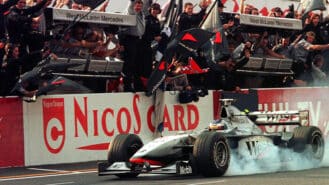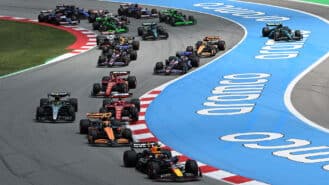One thing’s for sure about this year’s Bahrain GP. It got Formula One much more mainstream media coverage than usual, even in America.
The New York Times led last Saturday’s edition of its International News pages with a less than complimentary two-page story about F1 in Bahrain. I believe the last time the New York Times lavished such coverage on F1 was a few years ago during Max Mosley’s sex scandal.

Still, hope springs eternal in the breasts of American F1 fans that Formula 1 will soon re-establish itself in America as a credible sport. Everyone hopes the debut race at the Circuit of the Americas in Austin, in November, will take place in good order and cast F1 in a good light in the United States. And then there’s Weehawken, just across the Hudson River from Manhattan, scheduled to run in 2013 or ‘14, depending on who you believe. It would be a great thing if these races, one in the deep southwest, the other on the east coast in the shadow of New York City, could establish themselves as successful United States GPs. Let’s hope so.
Of course, I could prattle on for hours about the steep hurdles, financial and otherwise, both Austin and Weehawken must clear before they become regular rounds of the World Championship. Most people expect the races to last only a few years before hitting serious financial problems and, based on the sad recent history of Formula 1 in the United States from Indianapolis to Phoenix, Detroit, Dallas and Las Vegas, it’s hard to imagine anything different taking shape.

More’s the reason, particularly in the aftermath of the 38th running of the Long Beach GP, to mull the tremendous strategic blunder Bernie Ecclestone made when he turned F1’s back on Watkins Glen in 1980 (above) and Long Beach three years later. Looking back with the benefit of hindsight it’s clear now that if Ecclestone had persevered with the Glen and Long Beach he would have long enjoyed two huge races in America, one on the west coast and one in the northeast, both with strong traditions and history.
Consider first of all Long Beach. Even though the crowds and media coverage are nothing like they were in F1’s brief seven-year run in Long Beach, or CART’s heydays through the late ‘80s and ‘90s, it remains America’s biggest street race. But without doubt had F1 hung in there and built a long-term relationship with Long Beach, the race would be bigger than ever today and the track and pitlane could have been upgraded to modern F1 standards. Long Beach was the perfect venue for F1 in America and a continuing string of United States Grands Prix West over almost 40 years would have had a tremendously beneficial effect on F1’s image and audience in America.
Had Bernie stayed with Long Beach he would also have restrained CART’s growth through the ‘80s. When CART replaced F1 in Long Beach it gave Indy car racing much greater credibility as a first-class form of street or road racing, helping initiate CART’s rapid expansion beyond the borders of oval racing. The first year CART ran in Long Beach, 1984, only 50,000 people showed up on race day, down some 30,000 on the last few F1 races. But the crowd soon recovered and surpassed F1, ultimately topping out in the mid-‘90s at around 95,000 on race day and 220,000 over three days. This year, promoter Jim Michaelian announced a three-day crowd of 170,000. Respectable, but nothing like the old days and nothing like F1 would draw if Bernie had stayed the course.

Then there’s Watkins Glen, a superb road course in a beautiful setting with a long history of American road racing going back to the 1940s. Formula 1 ran at the Glen from 1961-80 and it was the perfect home for the sport in America, only four or five hours drive from New York City. F1’s desertion of the Glen allowed the track to fall into bankruptcy and be taken over by the International Speedway Corporation, NASCAR’s publicly-traded, track-owning partner. The result was that NASCAR’s mid-summer appearance at the Glen is by far the track’s biggest event and has helped NASCAR expand its audience and credibility, much like CART’s move to Long Beach benefited IndyCar racing.
Had Ecclestone bit the bullet and hung in there he might have wound up owning the Glen and maybe Long Beach too, giving him real power in American motor racing. But as with Bahrain, F1 today is always about the next bag of gold rather than long-term planning and building the sport’s popularity in places that not only have a passion for F1, but are also the perfect and proper venues for Grand Prix racing.







